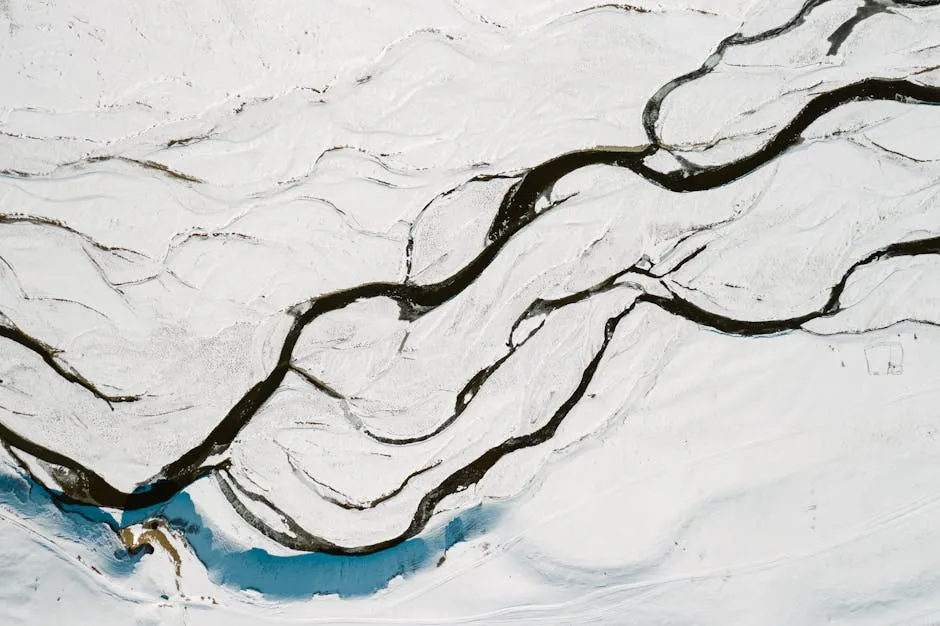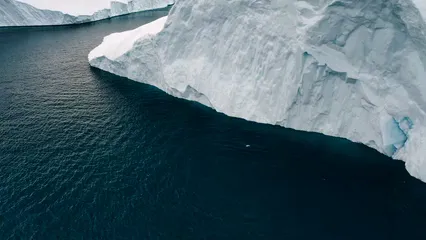
Why Does Ice Float in Water?
Introduction
Picture this: you’re chilling on a hot summer day, ice cubes clinking in your drink. Ever wondered why those cubes bob around instead of sinking like a rock? It’s a curious phenomenon that catches our attention. Ice floating on water is not just a quirky trait; it’s a fascinating aspect of water’s unique properties.
While most substances become denser when they solidify, water defies this norm. Instead, ice is about 9% less dense than liquid water. This unusual behavior can spark curiosity, prompting questions about the science behind it. Understanding why ice floats is not just a fun fact; it’s crucial for both scientific exploration and ecological balance. It affects everything from marine life survival to climate patterns. So, let’s dive into the scientific depths of this icy mystery!
While you’re at it, why not keep your drinks cold and refreshing all summer long? Check out this Insulated Water Bottle. It keeps your beverages icy while you ponder the mysteries of ice floating!

The Science of Ice Floating
Understanding Density
Density is the key player in the floating game. Simply put, density measures how much mass is packed into a given volume. The formula is straightforward: density = mass/volume. When you drop something in a liquid, its density determines if it sinks or floats. If the object is denser than the liquid, it sinks. If it’s less dense, it floats!
In our case, ice floats because it has a lower density than liquid water. Ice, made up of H2O molecules, occupies more space than water in its liquid state. This is a rare occurrence among substances, making water quite the oddball in the material world. So, when you see ice cubes floating, remember, it’s all about that density difference!
Archimedes’ Principle
Now, let’s introduce Archimedes’ Principle, which is the superhero of buoyancy. This principle states that any object submerged in a fluid experiences an upward buoyant force equal to the weight of the fluid it displaces. So, when you plop an ice cube into water, it pushes aside some water. The weight of that displaced water creates an upward force on the ice.
For ice to float, this buoyant force must be greater than or equal to the weight of the ice itself. Since ice is less dense than water, it displaces a volume of water equal to its weight, allowing it to stay afloat. In simple terms, ice floats because it’s less dense and creates enough buoyant force to counteract gravity. So, the next time you sip your drink with ice, remember: it’s all about science keeping your beverage cool and refreshing!
Speaking of refreshing drinks, have you tried making your own cold brew? A Cold Brew Coffee Maker can help you craft that perfect summer drink while you marvel at the science of ice!

Molecular Structure of Water
Composition of Water
Water, or H2O, is a simple yet extraordinary molecule. It consists of two hydrogen atoms and one oxygen atom. This combination forms a bent shape, giving water a polar nature. The oxygen atom carries a partial negative charge while the hydrogen atoms carry partial positive charges. This polarity is crucial, as it leads to the formation of hydrogen bonds between water molecules.
Hydrogen bonds are like the friendly hugs of the molecular world, holding water molecules together. These bonds are relatively weak and constantly breaking and reforming, especially in liquid water. When you heat water, the molecules move faster, breaking these bonds more easily. However, as water cools, these hydrogen bonds stabilize, affecting the arrangement of molecules significantly. This unique bonding structure is fundamental to understanding why ice floats.
Want to turn this scientific knowledge into a fun project? Grab a Science Experiment Kit to explore more about water’s fascinating properties!
Ice Formation
When water freezes, it undergoes a remarkable transformation. As the temperature drops, the water molecules lose energy and slow down. At 0°C (32°F), they start to arrange themselves into a crystalline structure. This crystalline formation is known as ice.
Ice has a hexagonal lattice structure, which is like a geometric pattern made of hexagons. In this arrangement, the molecules are spaced further apart than in liquid water. This is because hydrogen bonds in ice hold the molecules in fixed positions, preventing them from coming closer together. As a result, ice occupies about 9% more volume than the same mass of liquid water. This increase in volume leads to a decrease in density, making ice less dense than water.
This hexagonal lattice structure is a bit like a cozy, open cage that traps air, contributing to ice’s lower density. It’s a fascinating design that allows ice to float on water, a property that’s vital for life on Earth. If ice sank, bodies of water would freeze from the bottom up, drastically affecting aquatic ecosystems.

Why Ice is Less Dense than Water
Anomalous Behavior of Water
Water is full of surprises. One of its most unusual properties is that it becomes less dense as it freezes. Most substances behave differently; they typically become denser in their solid state. But water reaches its maximum density at approximately 4°C (39°F).
At this temperature, water molecules are packed closely together, making it denser than at any other temperature. When water cools further, it begins to expand instead of contracting. This expansion occurs because the molecules start forming the hexagonal lattice structure of ice. As a result, the ice takes up more space, leading to its lower density compared to liquid water.
This unique behavior is crucial, especially in natural bodies of water. As surface water freezes, it forms a layer of ice that insulates the water below. This allows aquatic life to survive in winter, even when the surface is frozen solid. Imagine the fish below, blissfully unaware of the chilly air above!
The relationship between temperature and density in water is what makes it such a remarkable substance. If ice sank, the consequences would be dire for marine ecosystems.
Understanding why ice floats isn’t just about satisfying curiosity; it’s vital for grasping how aquatic ecosystems and global climates function. Ice’s buoyancy plays a crucial role in shaping our environment, highlighting the intricate dance of water molecules that keeps life thriving beneath the icy surfaces.

Implications of Ice Floating
Environmental Impact
Ice floating is not just a visual spectacle; it plays a vital role in aquatic ecosystems. When ice forms on lakes and rivers during winter, it creates a protective layer. This insulation is crucial. It keeps the water beneath from freezing solid, allowing fish, amphibians, and other aquatic life to thrive despite the cold.
Imagine a frozen pond. The ice acts like a cozy blanket, maintaining a more stable temperature for the water below. This means fish can swim, and frogs can hibernate without fear of freezing to death. If ice sank instead of floated, bodies of water would freeze from the bottom up. This would be catastrophic for life, as organisms would be trapped in ice, unable to survive.
Moreover, floating ice contributes to the health of ecosystems. As ice melts in spring, it releases fresh water, which is essential for plants and animals. This seasonal cycle supports biodiversity and keeps habitats thriving. Floating ice is not just a pretty sight; it is a lifeline for many creatures.

Climate and Ocean Circulation
The impact of floating ice extends beyond local ecosystems; it influences global climate patterns and ocean currents. Ice plays a crucial role in regulating the Earth’s temperature. When sunlight hits the ice, much of it is reflected back into space, a phenomenon known as the albedo effect. This helps keep the planet cooler.
Conversely, when ice melts, darker ocean water is exposed. This darker surface absorbs more heat, accelerating warming. This feedback loop can amplify climate change, leading to rising sea levels and altered weather patterns. Researchers are closely monitoring these changes to understand their implications.
Floating ice also affects ocean circulation. Sea ice formation influences salinity and density in the ocean. When ice freezes, it expels salt, creating denser water that sinks. This process drives vital ocean currents, which circulate heat and nutrients around the globe. Without this circulation, ecosystems would be severely disrupted, affecting weather patterns and marine life.
In summary, the ability of ice to float has profound implications. It maintains aquatic ecosystems, regulates climate, and drives ocean circulation. Understanding these connections highlights the importance of preserving our icy environments in the face of climate change. The floating ice is more than just a physical phenomenon; it is a cornerstone of life on Earth.

Everyday Observations
Think about your favorite cold drink. Those ice cubes merrily floating at the top are a common sight. This phenomenon isn’t just a party trick; it’s a remarkable feature of ice and water. When you toss ice cubes into your glass, they float instead of sinking to the bottom. This scenario plays out globally, where massive icebergs effortlessly drift in the ocean.
But why do these cubes and icebergs stay on the surface? It’s all about density! Ice is about 9% less dense than water. This difference allows ice to float, creating a delightful visual while keeping your drink refreshingly cool. Next time you sip that iced beverage, give a nod to the science behind it.
The buoyancy of ice has practical applications beyond summer drinks! In engineering, understanding ice’s ability to float is crucial for designing ships and floating structures. Naval architects rely on this knowledge to create vessels that navigate our waters safely. Ice’s buoyancy also plays a significant role in environmental science. It helps regulate temperatures in aquatic ecosystems. When ice forms on lakes, it insulates the water below, allowing fish and other aquatic life to survive even in freezing temperatures.
In colder regions, floating ice serves as a crucial habitat for various wildlife. Polar bears and seals depend on sea ice for hunting and resting. Without floating ice, these creatures would face dire consequences, leading to disruptions in the food chain.

And if you’re planning a trip to enjoy the great outdoors, don’t forget to pack your Outdoor Waterproof Blanket for those chilly evenings by the water!
Conclusion
Understanding why ice floats is not just a matter of curiosity; it has profound implications for both science and life on Earth. This unique property of ice, stemming from its lower density compared to liquid water, plays a crucial role in regulating aquatic ecosystems. As ice forms on the surface of lakes and oceans, it provides insulation for the water below, enabling aquatic life to thrive even in frigid conditions.
Moreover, ice’s buoyancy influences global climate patterns. Floating ice reflects sunlight, helping to maintain cooler temperatures on Earth. Without this insulating layer, many species would struggle to survive, and ecosystems would face significant challenges.
In summary, the ability of ice to float is a fascinating interplay of molecular structure and physical principles. This characteristic not only shapes our everyday experiences but also underpins the delicate balance of life in our planet’s waters. Understanding this phenomenon encourages a deeper appreciation for the natural world and highlights the importance of preserving our icy environments in the face of climate change. So, next time you see ice floating, take a moment to appreciate the science behind it and its crucial role in sustaining life on Earth.
FAQs
Why does ice float while most other solids sink?
Ice floats because it’s less dense than water. Density measures mass per unit volume. When water freezes, its molecules arrange themselves into a hexagonal lattice structure. This structure creates spaces between molecules, causing ice to occupy more volume than liquid water. While most solids are denser than their liquid forms, water is unique. Its density peaks at about 4°C. Below this temperature, water expands as it freezes, making ice about 9% less dense than liquid water. This is why ice cubes bob around in your drink instead of sinking!
What would happen if ice sank?
If ice sank, the ecological consequences would be dire. Lakes and oceans would freeze from the bottom up, trapping aquatic life in solid ice. Imagine fish struggling to survive beneath a thick layer of ice! This scenario could disrupt entire ecosystems. The insulating layer of ice prevents the water beneath from freezing, allowing life to thrive even during the coldest months. Without this insulation, many aquatic species could face extinction, drastically altering food chains and biodiversity.
Are there other substances that float in their solid state?
Yes, ice isn’t alone in this quirky floating club! Bismuth, for example, is another solid that floats on its liquid form. Some polymers also exhibit this behavior. The unique molecular structures of these substances contribute to their lower densities as solids. While most materials follow the usual trend—becoming denser when solidifying—water, bismuth, and certain polymers break the mold, creating fascinating exceptions in the world of materials.
How does temperature affect the density of water and ice?
Temperature significantly influences the density of water and ice. Water reaches its maximum density at approximately 4°C. As it cools further and begins to freeze, the arrangement of water molecules changes. They form hydrogen bonds that create an open lattice structure in ice, which occupies more space and decreases density. Conversely, as water warms, it expands, leading to lower density. This temperature-density relationship is crucial for many natural processes, including the behavior of aquatic ecosystems and climate regulation.
Is the phenomenon of floating ice unique to Earth?
The floating ice phenomenon is not exclusive to Earth. Other celestial bodies, like certain moons and planets with water, also exhibit similar behavior. For instance, Europa, a moon of Jupiter, has a surface covered with ice that floats on a subsurface ocean. This floating ice is crucial for understanding potential habitats for life beyond Earth. The implications of floating ice in various environments highlight the importance of water’s unique properties, influencing both planetary evolution and the search for extraterrestrial life.
Please let us know what you think about our content by leaving a comment down below!
Thank you for reading till here 🙂 And don’t forget to enjoy your summer with a Beach Towel and some fun Outdoor Games!
All images from Pexels




